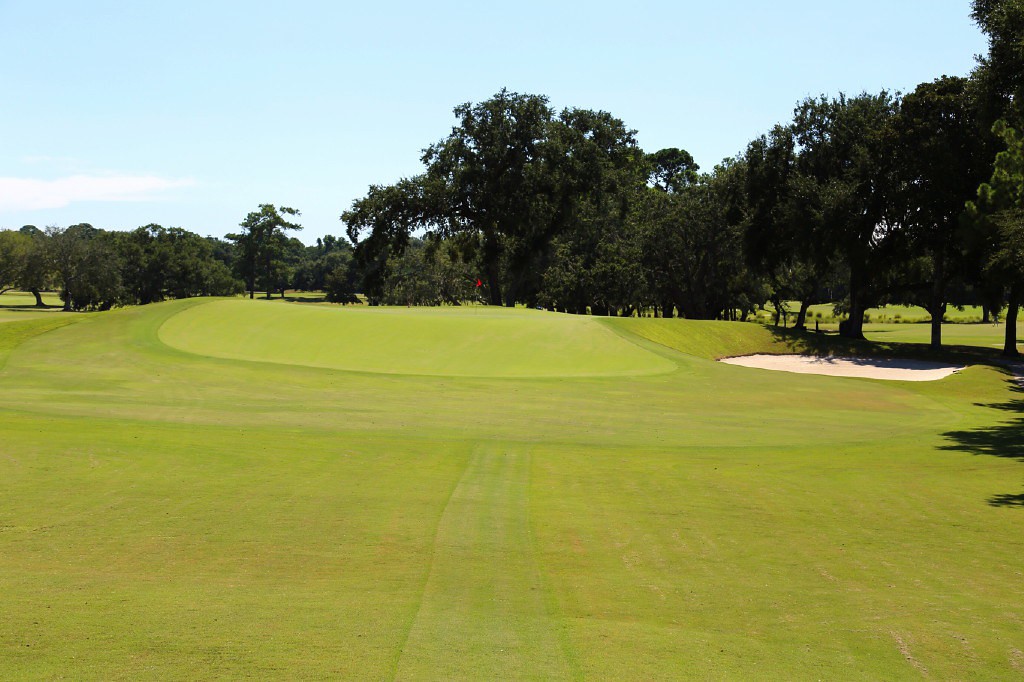There is nobody alive on this earth that knows more about the Country Club of Charleston golf course than Frank Ford III. He grew up there, the son of one of the club’s premier players, Ford captured various incarnation of the club’s important tournaments well over a dozen times and once carded a 62 on the par-71 layout. He also took home the trophy from the Azalea Invitational six times, the only person to do so. Other winners include future PGA Tour members Ken Green, D.J. Trahan, Casey Wittenberg, Webb Simpson, Ryuji Imada and C.T. Pan, as well as noted amateurs Billy Joe Patton, Dick Siderowf and David Eger (twice).
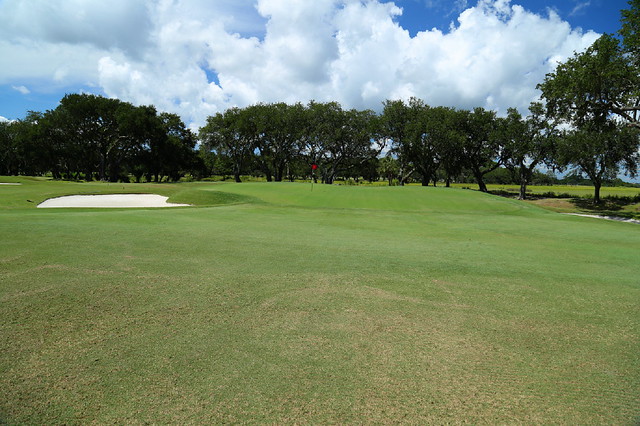
The seventh hole at Country Club of Charleston has a Maiden green, two tiers at the back of the putting surface.
With the U.S. Women’s Open coming to CC Charleston May 30 through June 2, no one is more qualified to give a primer on how to play the 1925 Seth Raynor design than Ford.
This will be the first time a Raynor original golf course will hold such a prestigious USGA event. Charleston and the Greenbrier’s Old White Course have hosted the PGA Tour, or the precursor to it.
Depending on course conditions and the weather, Ford expects the yardage to be between 6,500 yards and 6,700 yards and he is confident the layout will stand up to the best women players in the world.
As Ford will describe, Charleston presents a wide variety of challenges. The design cannot be described as a first-shot or second-shot golf course. Some holes call for accuracy off the tee, others do not, while other holes demand precise approach shots. Making Raynor’s creation even more impressive is the fact there is barely any elevation change across the entire property. All the strategy comes from the brilliant mind of Raynor.
Overlooked because of its close proximity to a more famous Raynor design, Yeamans Hall, Charleston deserves more accolades than it receives.
Prior to the U.S. Amateur coming to CC Charleston, Jeff Hall of the USGA walked the course with Ford and according to Ford had this to say when they reached the final hole.
“I’ve never seen 18 better green complexes on one golf course.”
Ford concurs.
“The great thing about our golf course is we have 10 great hole locations on every green,” Ford said.
(All yardage approximate as to how the hole will be played during the tournament)
No. 1, Westward Ho, 420 yards:In 1988 Ford defeated Jay Sigel and Scott Gump to win the Azalea in a playoff. During play on Saturday, Ford drove the ball into the right fairway bunker, hit a 9-iron short of the green and made up-and-down for par. On Sunday he captured the title on the fourth playoff hole.
The next day in the clubhouse Ford encountered the great professional golfer, former CCC assistant golf pro, and longtime CCC member, Henry Picard (pronounced pick-erd).
According to Ford, he was not greeted by a congratulations from Picard who won 26 PGA Tour events including the 1938 Masters and the 1939 PGA Championship and three consecutive Tournament of the Gardens played at CCC.
“Frank, I just want you to know that I’ve never driven it into the right bunker on 1 at Charleston,” Picard said told Ford, leaving Ford stunned into silence, before Picard added, “Oh, by the way you played great.”
Obviously keeping out of that bunker is imperative.
“It can kick you I the teeth to start, it usually plays into the wind,” Ford said, adding, the green does not play as large as it appears.
No. 2, Valley, 380 yards:Ford, a right-handed player who fades the ball, usually lays up off the tee. A pair of fairway bunker are in play for those who don’t. Although the green opening points to the left, Ford prefers to come into the putting surface from the right even though that means carrying greenside sand.
No. 3, Eden, 170 yards:Charles Blair Macdonald thought the only problem with the Eden Hole, no. 11 at the Old Course, St. Andrews, Scotland, was it could be played with a putter and so when he designed his versions there were invariably cross bunkers between tee and green. At CCC, Raynor, a protégé of Macdonald, designed a version with cross bunkers; not always the case when he laid out an Eden.
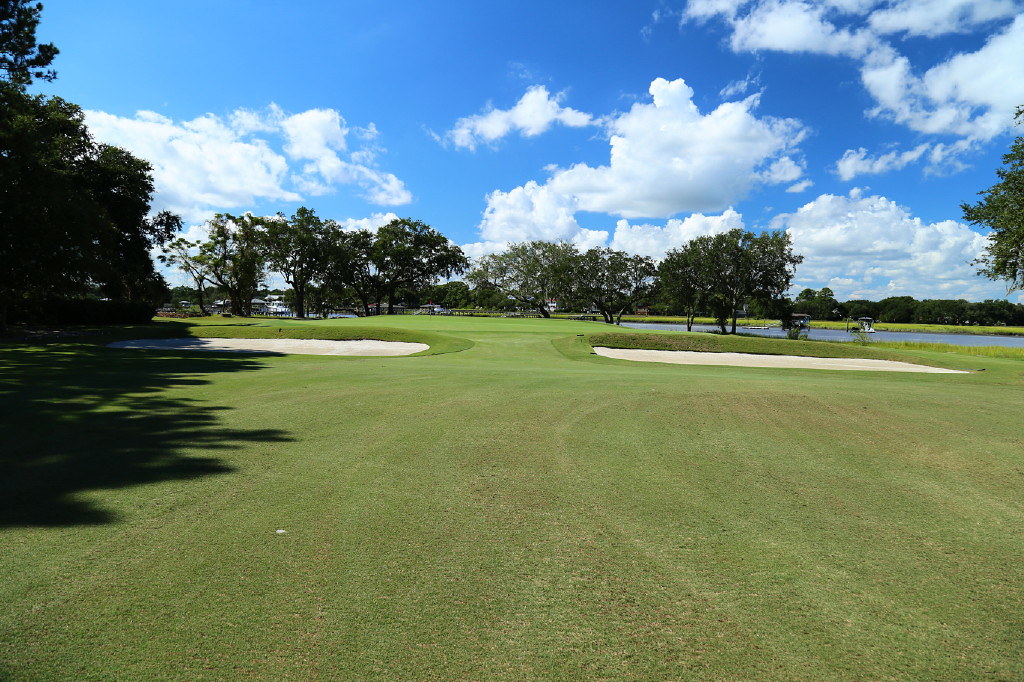
The tenth hole at CC Charleston is of the Alps variety and is bear if it is the first hole of the day. Wappoo Creek is in the background.
The sand won’t come into play for the women but the hole should present a stiff challenge, with wind most likely out of the right.
Ford says of the third, “it is one the most crucial club selections” on the front nine and prefers to play for the middle of the green. He warned that anyone who misses the putting surface on the short side will not get up and down.
No. 4, Leven, 400 yards:The first decision is whether or not to carry the diagonal fairway bunker on the left side of the hole, a length of approximately 240 yards.
“You definitely have to play from the left side, no matter the flag,” Ford said. “It’s much more difficult from the right.”
With the prevailing wind from the right and pushing shots to the left where woods line the entire fairway, taking the bold rout requires fortitude.
No. 5, Narrows, 500 yards:Called “the most friendly hole on the golf course,” by Ford who says longer players should be able to reach the green in two. For those who try, though, there is one place that the golf ball cannot come to rest.
“You don’t want to go over that green ever, ever,” Ford emphasized.
Those trying to reach with a pair of mighty blows and those taking it on as a three-shot hole should make sure their tee shots stop on the left side of the fairway.
No. 6, Pond, 210 yards:This hole baffles many of the Raynor aficionados. This par-3, with no bunkers, has to be a mistake, they say. Raynor must have intended this to be a Biarritz, put in a swale, for god’s sake.
They are wrong. Raynor created a one-of-a-kind here. The detailed plans of the layout show the hole much the way it is now. Kudos to the club for resisting the attempts to make it a Biarritz.
As it exists, the sixth is dastardly.
“This is the most pivotal hole on the front to play well,” Ford said.
He added that this another example of a green that plays smaller than it appears. Because of that, Ford knows he will often miss his target… but in the correct spot.
According to Ford, Picard told him, “If you ever have indecision on what club to hit on six hit the shorter club. It is much easier to pitch up the front than left or right.”
Ford said, “a 60-foot shot from the front is better than a 30-foot shot from the right or left. For me, if I make a three, I carry the momentum into 7 and 8.”
If the conditions are firm for the tournament and the prevailing wind is there, the hole could be played from the tips at 225 yards.
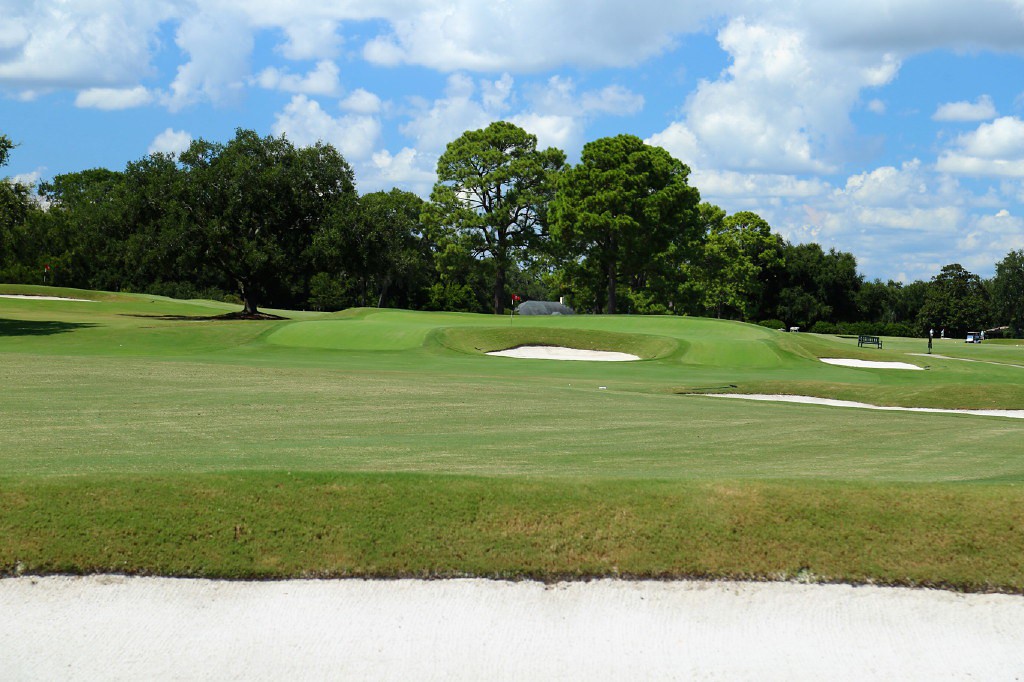
The front bunker of the Lion’s Mouth green, on the 16th hole, dominates players’ vision and thinking.
No. 7, Maiden, 370 yards: It may appear to be a breather, but this hole is not
“You have to hit a better drive than you think; you must be in the fairway,” Ford said.
Golfers will most likely have a short iron for the approach but trouble lurks for misses. According to Ford, if the hole location is in the back, one must be on their number to go for the flag since the greenside bunkers can inflict misery.
“Man, they bite you fast,” he said.
No. 8, Meadow, 380 yards: “The hole plays tougher than it looks,” is Ford’s assessment, and here’s why.
The wide fairway is tilted from right to left but the wind blows in the opposite direction, pushing shots toward a pond down the right of the entire hole. The idea is to come in to the green from the left but most golfers, according to Ford, choose the right, which appears much more inviting off the tee. The green is well-protected. Don’t be surprised to see longer hitters forgo driver.
No. 9, Long, 535 yards: Only the biggest of hitters will go for this green in two, so for everyone else laying up, “The second is the most important shot on the hole. You have to stay out of the bunker,” Ford said. “It’s a sleeper shot.”
The right side fairway hazard to which he refers is about 110 yards from the putting surface.
Still, though, he expects the hole to yield more birdies than bogies.
No. 10, Alps, 370 yards: Unfortunately, everyone will begin a round here.
“I hate starting on this hole,” Ford said with the memory of past foibles evident in his tone.
The driveway into the club is on the left and the driving range is on the right. A through bunker on the right, approximately 260 yards out, stares back at the tee.
Ford lays back, taking the bunker out of play and leaving himself 150 yards to 160 yards for his approach. Avoiding a big number is imperative.
“You don’t want to walk off that hole with a bad attitude,” Ford said, keenly aware of what lies immediately ahead.
No. 11, Redan, 160 yards: The reason a positive outlook is important is that 11 is the most controversial, well-known and perhaps most penal hole on the course.
“It’s been the most talked about hole for 100 years,” Ford said. “Like no. 12 at Augusta National, it’s a hole you are thinking about long before you get there.”
Not everyone is a fan. Sam Snead made a 13 there and Ben Hogan thought it should be blown up.
Eleven is a Reverse Redan, meaning it cants from the left to the right, diagonally away from the line of play. The gargantuan green complex was built on an existing mound, an anomaly on the flat site. The tee is from the same height as the green surface so the carry is over a large valley. As with nearly all Raynor holes of this type, bunkers leer from the right and left.
To make up-and-down from the right sand, Ford puts the difficulty at 6 or 7, from the left it is a 9.
Beth Daniel, a member of Charleston as well as a member of the World Golf Hall of Fame thanks to her 33 LPGA Tour victories, including one major, offers some sobering advice on how to play the 11th, according to Ford.
“I tell people to consider laying up on that hole,” Ford said repeating her words and agreeing with her assessment.
“Eliminate the big number,” Ford said and for him that might mean chipping backwards out of the bunkers.
Buddy Alexander, the former standout amateur golfer who won the Azalea, the U.S. Amateur, played on a Walker Cup team and coached the Florida Gators men’s golf team for 26 seasons, told Ford, “You should never make more than a five on number 11.”
Jack Nicklaus never played the hole but after inspecting it, told Ford that in a four-day competition, he would expect to play it one or two-over.
While it is what Ford terms a “disaster hole,” he still considers it fair, but added a caveat on how well the tee ball must be played for par or better to be made.
“If you take it on, a good shot might not be good enough,” he said.
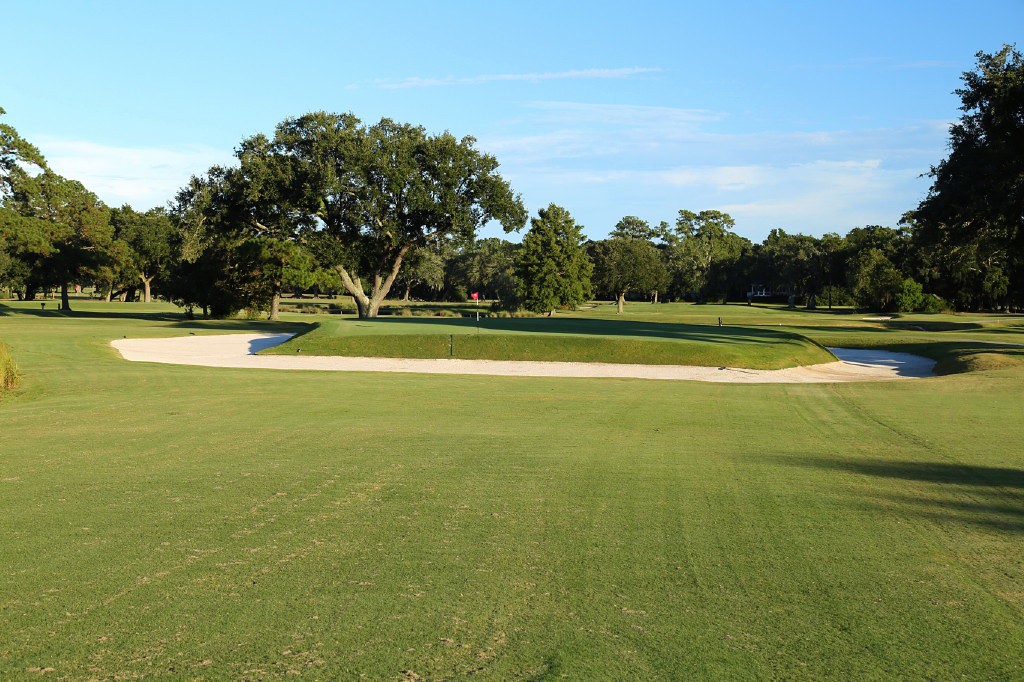
The 17th hole, Short, will produce plenty of heartache for those who miss the putting surface during the U.S. Women’s Open.
No. 12, Road, 340 yards: Another hole that confounds those that claim to know all there is about Raynor.
Think of quintessential Road holes whether they be from Raynor, Charles Blair Macdonald or Charles Banks and invariably they are all stout par-4s or tough par-5s. Not so at CC Charleston. This might just be one-of-a-kind in the Raynor repertoire, a drive-and-pitch version.
The psychology of the design is undeniable: walk off the 11thgreen whether it be with head held high or head hung low and the 12thseems like a chance to ease up slightly, to catch your breath.
“One of our best holes, you walk off 11 and let your guard down,” Ford said.
That, in turn, will only lead to trouble as the fairway spills to the right and the left.
“You better be prepared to hit a golf shot off the 12thtee,” Ford added.
At the green, the Road Hole bunker awaits, seeming to dominate the field of vision for players who may have nothing more than a sand-wedge in their clutches. Especially when the flag to front right, but even when it is positioned elsewhere, avoiding the sand is at the forefront of the strategy. A birdie, though, can be made here.
“He (Raynor) knew 11 was going to give you trouble,” Ford opined. “He gives you a chance to make up for it.”
No. 13, Wappoo, 370 yards: The original name of the present course was the Wappoo Links and this hole carries on the moniker. It, too, can be birdied if played correctly.
Rough has been grown in on the left side of the fairway pushing players to the right, which Ford says is the correct way to approach the green, giving the players a look up the axis of the putting surface. Many of the participants may choose to lay up, which Ford says is wise choice. No matter what, on the second shot the ball cannot go over the back of the green. Two feet too long and the mishit will only stop when it is out of bounds.
“You don’t want any club that could take you over the green,” Ford said.
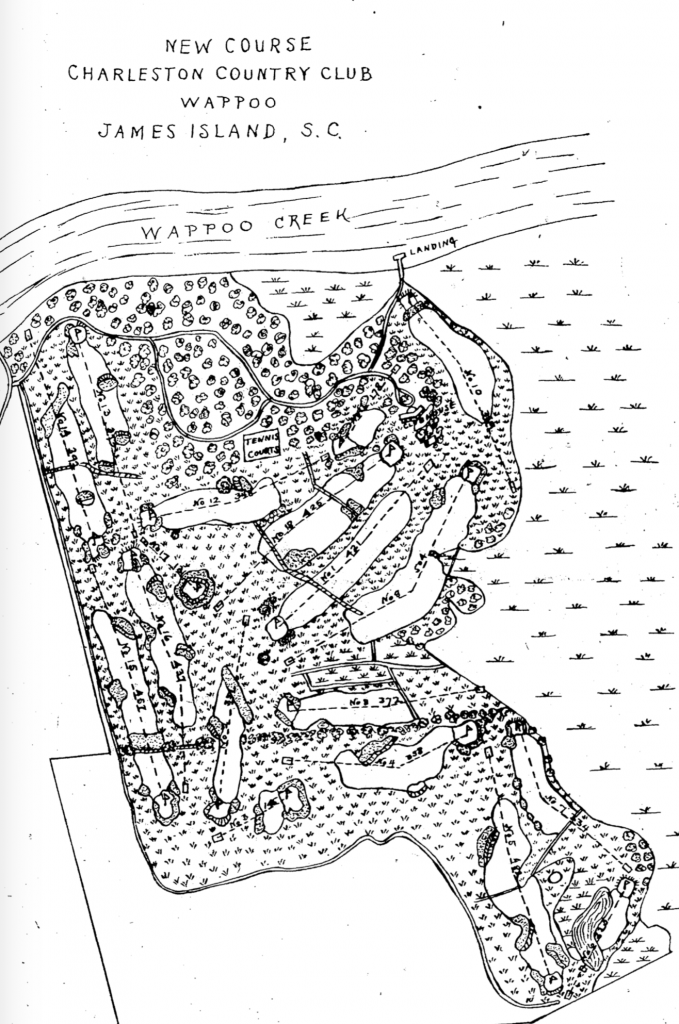
An illustration of the course that appeared in the May 16, 1925 edition of the (Charleston) News and Courier newspaper, coinciding with the opening of the layout. The drawing was done by CCC member Edward F. Mayberry.
No. 14, Double Plateau, 340 yards: The name is a misnomer, this is merely a two-level putting surface and not a double plateau in the way Raynor designed them, but that does not mean it is a disappointment.
“In my opinion, this is the best green on the course,” Ford said.
His advice is to see where flag is located and then determine the course of action.
“You want to play this hole backwards, hit the right tee shot to give you the number in. These are the toughest hole locations (on the course) to get close to with a short iron. It’s all about the green,” Ford said.
One tantalizing prospect is that for one round the tees may be moved way up creating a drivable par-4.
No. 15, McLeod, 500 yards: Named for the family that once owned the land on which the course sits, the 15th has a bit of controversy to it in the way of a berm that runs across the entire fairway, approximately 135 yards from the hole.
In 2006 when Brian Silva sympathetically restored the layout, he not only restored the mound, which had been removed, but also convinced the membership to let the grass on it grow wild. One tree on each side of the fairway are large enough to warrant attention on the layup shot.
Ford is a fan.
“It puts some pizazz on a good hole that makes you think on the second shot,” he said. “You need to be thinking about if off the tee.”
The original Raynor drawings show a flat sand bunker on the tee side of a drainage ditch, ostensibly to prevent balls from finding it. Somewhere along the line the ditch was filled and the berm created.
Also, between 2016 and 2018, architect Kyle Franz did bunker work at CCC including quadrupling the size of a right fairway bunker that is in play off the tee.
This should be a hole, however, that yields plenty of low numbers.
“You have to be thinking birdie off the tee,” Ford said.
No. 16, Lion’s Mouth, 435 yards: After the 11thhole, this green will likely receive the most attention from the media covering the Women’s Open.
It is a massive, manufactured complex that appears to dominate the skyline and has no equal among surviving Raynor designs and may have never had a rival. The top edge of the Lion’s Mouth bunker is 10 feet above grade. The back edge of the complex is two feet higher. Like other Raynor holes at Charleston, conquering the 16thstarts at the tee.
Four fairway bunkers, two on each side of the landing areas demand that players hit a precise tee ball. The second shot will require at least a club more due to elevation as the gigantic front hazard looms, but a defining characteristic of the green, over looked by many of the hole descriptions, will be taken advantage of by the savviest of players.
The green is actually of the Punchbowl variety. The sharp rise around the sides and back can be used to the golfer’s advantage. Shots that don’t challenge the bunker can be redirected back towards the middle of the putting surface.
“It feeds from the right, left and back and can feed slightly from the front,” Ford said. “The ball rolls around on that green more than any other.
Still, it’s a tough hole.
“There’s not going to be a lot of double bogies, but there will be a lot of bogies,” Ford said.
No. 17, Short, 155 yards: This is a quintessential Short hole. The green is large and a “thumbprint” or “horseshoe” depression dominates the putting surface, which is ringed in sand.
Cups positioned on the outside of the feature should probably be avoided off the tee.
“If you challenge those hole locations, you better hit a golf shot,” Ford said.
He advises playing for the center of the putting surface for anyone in the lead. Doing so, however, does not guarantee a par.
“All the putts out of the thumbprints are testy,” Ford said.
No. 18, Home, 470 yards: “I’m biased, but I think this is one of the finest finishing holes anywhere,” Ford commented without a hint of regret.
With three fairway bunkers in play, the hole calls for a great first and second shot and a pinpoint accurate approach. A deceivingly tough green that sits more above fairway level than evident at first look brings an end to the design.
The right third of the green, according to Ford, tilts to the right and what might look like a fine approach shot that might even land on the putting surface could spill off into sand or the chipping area. Sounds like a perfect location for a Sunday flag.
“There’s not many doubles or birdies there, but a lot of bogies,” Ford said.
For the course to stand up to the world’s best players, nature will have to play a role.
“We’re all hoping for a breeze,” Ford said. “It’s likely the breeze will be from more than one direction over four days.”
Even with wind, Ford expects scores in the mid to low 60s to be carded.
“That wouldn’t disappoint me if that happens,” he said.
When all is said and done, Ford said he hopes the course plays as was intended and the man who designed it is lauded for the outstanding work.
“I hope what happens is that Mr. Raynor gets the credit he deserves, Ford said. “I hope Mr. Raynor gets his due.”
(All photos: Brett Zimmerman)

